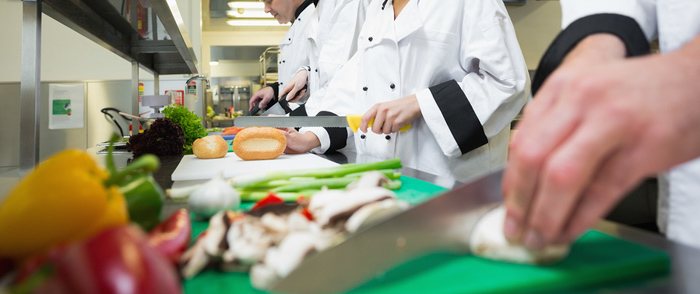Restaurant Safety Tips to Help Protect Employees and Customers from Injury

Taking steps to keep your employees safe will help keep customers safe.
Restaurant safety is a legitimate concern for small businesses. Food industry workers have a 60 percent higher chance of occupational injury or death than the average worker, according to data analysis conducted at Emory University.
The most common injuries may surprise you:
Chemical Exposure
While you probably think of food when you picture a restaurant, keeping the space clean is a major concern. Unfortunately, commercial cleansers used to do things like remove grease and grime, kill food-borne bacteria, sanitize dishware, and keep tablecloths and napkins clean and fresh can all contain strong and potentially caustic agents. Exposure to cleaning chemicals, such as ammonia and bleach, can cause skin rashes, eye irritation and respiratory problems.
Strained Muscles
Back, neck and shoulder sprains are common occurrences in the food service industry. Servers often attempt to carry too much at once and bend at odd angles to place a tray on a stand or table.
Burns
There are so many hot surfaces in a restaurant kitchen that burns are a constant concern. Stovetops, ovens, deep fryers, pressure cookers, steamers and hot water all can cause serious burns — not to mention candles and hot drinks.
Slips, Trips, and Falls
Liquid spills are a major cause of employee and customer falls, whether due to a spilled drink, dripping sinks or leaking stove grease. Uneven or broken flooring and ripped carpets are other hazards.
Cuts
Knives used in food preparation present an obvious risk, but broken dishware and glasses can be hazardous, too.
Assaults
Delivery and drive-through personnel are at risk of injury from unscrupulous customers and are frequently targeted because they are responsible for money.
Fortunately, there are a number of things you can do to uphold restaurant safety.
- Show employees when to use hot pads and trays to carry hot dishes, how to handle hot liquids and how to treat burns with basic first aid.
- Do a refresher training on how to lift and carry heavy items to reduce the risk of pulling or spraining muscles. Consider reviewing Food Services of America's guidelines on how to safely move heavy loads.
- Add plenty of lighting. This can help prevent slips and falls by helping employees spot spills and slippery areas.
- Repair torn or worn carpet. Fix uneven sidewalks or tile flooring.
- Use labels to draw attention to changes in floor height.
- Put up mirrors around blind corners to prevent collisions.
- Label potential hazards. OSHA regulations require that chemical hazards be identified through labels and data sheets. But additional plain language labels that clearly spell out warnings can also help.
- Ensure that delivery drivers and cashiers are trained on what to do if there is a robbery or assault.
Taking steps to keep your employees safe will help keep customers safe, too, so get your whole team on board in making safety a priority.



